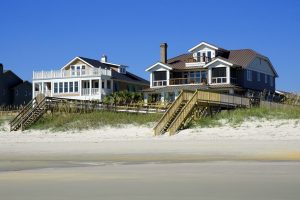Building a House on a Sandbar
Posted on September 2, 2017 in Buying Tips.
 With its beautiful beaches and inviting waters, there are very few places as relaxing, as perfect for a vacation or a weekend getaway, as the Outer Banks. That’s why hundreds of thousands of visitors arrive every week during the summer, and even in the shoulder seasons people still look forward to some time by the sea.
With its beautiful beaches and inviting waters, there are very few places as relaxing, as perfect for a vacation or a weekend getaway, as the Outer Banks. That’s why hundreds of thousands of visitors arrive every week during the summer, and even in the shoulder seasons people still look forward to some time by the sea.
With that popularity, quite a number of our visitors think about moving to the Outer Banks either to work or retire. Many look to build locally, either as a second home or primary residence. Building in an environment as remarkable as the Outer Banks is different from most other locations, and there is some information first time property owners planning to build need to be aware of when they begin their project.
This is general information. There are many reputable and very good builders and contractors on the Outer Banks who can fill in the details.
CAMA
An acronym for Coastal Area Management Act, the regulations covered by CAMA are administered by the Coastal Resources Commission and enforced by the NC Department of Environmental Quality. CAMA regulations and permits cover any area of environmental concern (AEC) in the 20 coastal counties of North Carolina. An AEC is defined by CAMA as, “…an area of natural importance: It may be easily destroyed by erosion or flooding; or it may have environmental, social, economic or aesthetic values that make it valuable to our state.”
In their literature about permits and regulations, CAMA note that AECs only pertain to about 3% of the land within its jurisdiction. That figure is certainly higher in Dare County and along the Currituck Banks, but it is a valid point that not every construction project on the Outer Banks requires a CAMA permit.
However, for projects that do fall within CAMA guideline, it is imperative that a permit is issued. CAMA enforcement includes work stoppage and fines, and in some cases the fines are assessed daily until the infraction is corrected.
For the most part, CAMA regulations protect wetlands and areas near the shoreline, shorelines that include the ocean and sounds.
CAMA has created a list of general guidelines for when a project might need a permit:
▪ in, or on the shore of, navigable waters within the 20 CAMA counties;
▪ on a marsh or wetland;
▪ within 75 feet of the normal high water line along an estuarine shoreline;
▪ near the ocean beach;
▪ near an inlet;
▪ within 30 feet of the normal high water level of areas designated as inland fishing waters by the N.C. Marine Fisheries Commission and the N.C. Wildlife Resources Commission;
▪ near a public water supply;
▪ within 575 feet of Outstanding Resource Waters defined by the Environmental Management Commission.
Outer Banks builders and contractors are aware of the guidelines and should be able to get the necessary permits if required.
Weather
On a beautiful summer day with the surf running at 2’ and a gentle southwest breeze, it may be hard to imagine how harsh the environment is on buildings. But it is. The Outer Banks is considered one of the most severe environments for building in the United States.
There is always some salt content in the air and that is exacerbated in the winter when northeast winds dominate and nor’easters track up the coast. There is also almost always moisture in the air. That combination of salt and moisture is very corrosive.
The FEMA guidelines put into perspective what to expect:
“Materials and construction methods in a coastal environment should be resistant to flood and wind damage, wind-driven rain, corrosion, moisture, and decay…”
Wind is certainly a concern on the Outer Banks and all newly constructed buildings must be able to withstand a 120 mph wind.
Construction
Outer Banks homes have two somewhat unique characteristics in their construction—pilings and septic systems.
Pilings
Almost every home on the Outer Banks is built on pilings, and there are two very good reasons for that. Neither is more important than the other, and in combination, they make a good case for elevating the structure.
Even though the latest FEMA flood zone maps have moved much of the northern Outer Banks into more favorable flood zone designations, the fact is, this is a low lying area susceptible to ocean overwash or soundside flooding during storms. Elevating the structure is the most effective way to stop 6” of water from creeping into a home.
The other reason for building on pilings is two closely related factors.
Inland areas typically have dense soils with a ground water table at least 6’-8’ below the surface and usually more. Neither is the case on the Outer Banks. The soil is sandy and the water table is just below the surface. Basement construction typical of homes inland is not practical with those environmental factors.
In some of the higher elevations, the water table is deeper, but the soil still tends to be sandy.
Septic Systems
Except for an area of the central business district of Kill Devil Hills, there are no central sewer systems on the Outer Banks. Waste is handled by septic systems that are part of the homeowner’s property and responsibility.
Because of advances in technology, septic systems have become very efficient, and the effect on new home construction should be minimal if it is even apparent. However, some older smaller lots in Kitty Hawk, Kill Devil Hills and Nags Head could limit the size of a structure.
Remember—septic systems do need to be maintained.
This information is designed to guide but is not definitive. As is always the case, a reputable builder who understands local ordinances and building codes is the key to a successful project.
Is Building A Home An Option For You?
Posted on May 8, 2015 in Buying Tips.
 Determining whether to build a home or purchase an existing home may seem like a simple decision. Yet, in fact, there are many more factors to consider. Weighing a list of wants with your current budget and knowing all the facts are key in making this personal and very important life decision.
Determining whether to build a home or purchase an existing home may seem like a simple decision. Yet, in fact, there are many more factors to consider. Weighing a list of wants with your current budget and knowing all the facts are key in making this personal and very important life decision.
Questions such as these below are items to consider when looking to build or buy an existing home:
- What is the difference in building or buying an existing home?
- What are the costs involved?
- What are the loan products available?
- How do we pick a home site?
- Which builder should I choose?
- Do I have to pull permits?
- What choices do I have to make?
- Who covers the insurance while it is being built?
- How will I know what is going on if I live out of the area?
- Do I get a warranty?
- Who provides the home plans?
- What if I want to make a change while it is under construction?
- What are the benefits to buying an existing home?
- How long will it all take?
- Does the community have an Architectural Review Committee?
- Can our marriage handle building a new home?
- Who gets the lot ready to build?
- Will I sign a contract with a builder?
- Is Landscaping included?
- Can I incorporate Green/Energy saving materials into the build?
These are all questions with answers that vary with the builder, area, size of the home, and preferences of the buyer.
Building a home can be a fun process, but it’s not for everyone. Loan products generally call for 20% down (20% total-house and lot). It generally takes 6 months to a year to complete. There are many selections to choose from when picking cabinets, appliances, colors, siding, shingles etc, which takes time, coordination, and can often benefit from expert opinion.
The advantages to buying an existing home include closing, usually, within 35 days, move right in, and loans that require less money down. The advantages to buying a lot and building a home include a warranty, minimal maintenance for the first 5-10 years, designing the home exactly to fit your needs, and generally a higher resale.
The best measure for a builder that I have found is the relationship that a builder has with his clients after the project is finished. If a builder has a positive relationship with a good percentage of his past clients it shows to me that he finishes well and that everyone has a positive experience when dealing with them.
Please feel free to print the above list of questions. As a Realtor, I have had the pleasure to help several clients buy lots, coordinate with a builder, and assist them through the entire project. From 1100 sq ft Beach Box style homes to 9,000 sq ft rental machines, no project is too small or too big. We can assist you in making your dreams into reality.
Remodels can be an option too. There are many construction to permanent type loan products available which allow you to buy a home that needs updating. You and the lender can formulate a plan for the scope of the work, coordinate with a contractor, and the work begins immediately after closing.
We have several builders that we have worked with over the years, don’t hesitate to contact me, let my years of experience go to work for you.
 Pete Salitore, Associate Broker
Pete Salitore, Associate Broker
petesalitore@gmail.com
252-202-4868





